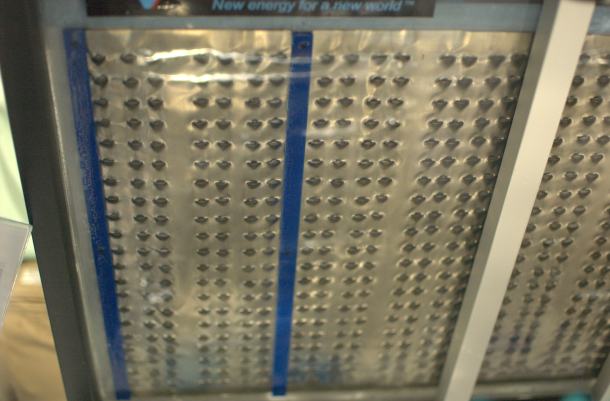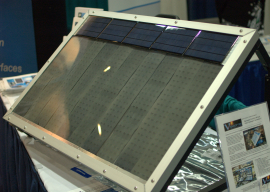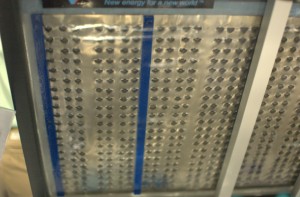BOSTON–One of the barriers to the long-hoped-for hydrogen economy is a non-polluting energy source for hydrogen. Nanoptek is one company that’s tapping the sun’s energy.
The Maynard, Mass., company this week said it is taking orders for a commercial solar hydrogen generator, which is now in pilot production. The company showed a smaller version of its product at the TechConnect conference here.

These specially-coated titanium strips react to sunlight to produce hydrogen from water pumped into the device. (Credit: Martin LaMonica/CNET)
Nanoptek envisions creating a system for storing energy from solar at large scale, making hydrogen for vehicles, and even home fueling. In the nearer term, though, the company is seeking to sell solar generators to businesses that now buy tanks of hydrogen for industrial use.
The company’s product, called the Solar Hydrogen Generator 300, is slightly bigger than a typical solar photovoltaic panel, measuring two meters wide and one meter high. Like a traditional electrolyzer, it applies a voltage to a liquid electrolyte to break apart the hydrogen and oxygen atoms in water. The hydrogen is stored in tanks and used in a fuel cell to make electricity.
What’s different is that Nanoptek’s device can produce hydrogen from water using about one-third the electricity of a typical electrolyzer, said CEO John Guerra. The key is a titanium dioxide coating that is activated by both ultraviolet and visible blue light, he explained.
Its photocatalyst material is a titanium dioxide that’s baked onto strips of titanium metal, which is “stressed” with a nanostructure before coating. The surface treatment allows electrons to be released with the lower energy available from visible blue light, Guerra explained. The flow of electrons into the water causes the hydrogen and oxygen atoms in water to split apart.
Because the photo catalyst reacts well to this type of light, the solar hydrogen generator can work well on cloudy days, he added. The company calls it a hybrid device because the generator can operate as a traditional electrolyzer from grid power when there is no sunlight available.

A prototype solar hydrogen generator. The solar PV panel provides the voltage needed to split water, making it more efficient. (Credit: Martin LaMonica/CNET)
The company’s panel includes both strips of titanium and an optional row of photovoltaic cells, which provide voltage for the water splitting to occur and make the process more efficient. As water is pumped in, the hydrogen gas captured.
The idea of making hydrogen as an energy carrier for vehicles and grid storage has been around for years, but there are a number of technical barriers, such storing hydrogen in a small footprint for vehicles and finding inexpensive catalyst materials. Also, there isn’t a distribution infrastructure for transporting hydrogen apart from transporting tanks.
Still, with growing interest in cleaner energy, there remains a lot of research and development work. SunCatalytix, which was spun out of the Massachusetts Institute of Technology, is working on what it calls an “artificial leaf” also designed to make hydrogen from water using a solar photovoltaic cell. In addition to technical challenges, finding customers willing to try out the new technology is also a challenge.

 Follow
Follow